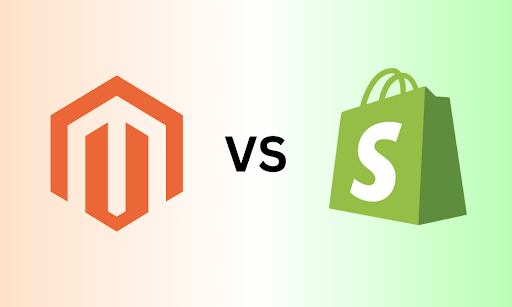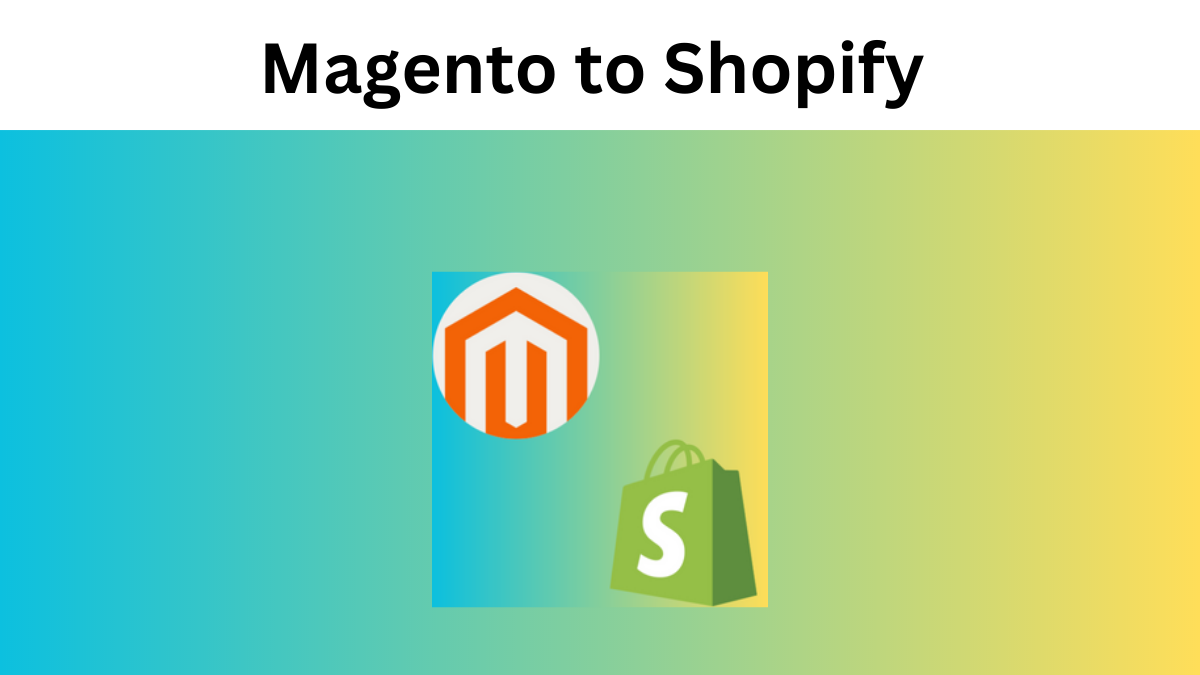How to Migrate from Magento to Shopify in 2025
In today’s competitive e-commerce landscape, choosing the right platform is crucial for business success. This article explores the benefits of migrating from Magento to Shopify, by comparing their features like customizability, and scalability, …. Discover how this transition can enhance your business can help you find out if your business is suitable for the migration or not. So, let’s dive in how this migration can boost your e-commerce success and make the migration process as soon as possible.
Contents
Magento and Shopify Comparision

Magento and Shopify are both popular e-commerce platforms, each with its own strengths and considerations. Let’s compare them based on several key factors:
1. Customizability
Magento: Known for its robustness and extensive customization options, Magento offers a high level of flexibility. It allows businesses to create highly customized and complex e-commerce stores tailored to their specific needs. However, this customization often requires technical expertise and development resources.
Shopify: While not as customizable as Magento, Shopify provides a user-friendly interface and a wide range of customizable themes. Its drag-and-drop functionality and theme editor make it easier for users to customize their stores without extensive coding knowledge. Shopify’s focus on simplicity and convenience may limit some advanced customization options.
2. Scalability
Magento: Magento is renowned for its scalability and is a preferred choice for large enterprises and businesses with complex requirements. It can handle high volumes of products, transactions, and traffic, making it suitable for businesses with significant growth potential.
Shopify: While also scalable, Shopify is designed to cater to businesses of various sizes, from small startups to enterprise-level operations. It can handle moderate to high levels of traffic and transactions. However, Shopify’s scalability may have some limitations compared to Magento’s more robust capabilities.
3. App and Theme Marketplace
Magento: Magento offers an extensive marketplace called the Magento Marketplace, providing a wide variety of themes, extensions, and integrations. This allows businesses to enhance their stores with additional features and functionality. However, the quality and compatibility of third-party extensions can vary.
Shopify: Shopify boasts a large app and theme marketplace, known as the Shopify App Store and Shopify Theme Store. It offers a vast selection of professionally designed themes and a wide range of apps and integrations. The Shopify ecosystem provides a well-curated collection of solutions to enhance the functionality and appearance of your store.
4. Hosting and Maintenance
Magento: With Magento, you have the flexibility to choose your own hosting provider. This gives you control over server performance, security, and costs. However, it also means you are responsible for managing and maintaining the hosting infrastructure, which can be complex and require technical expertise.
Shopify: One of the key advantages of Shopify is its fully managed hosting. Shopify takes care of hosting, server maintenance, security, and updates, ensuring that your store remains reliable and secure. This eliminates the need for businesses to manage hosting infrastructure independently, allowing them to focus on running their online stores.
5. Pricing:
Magento: Magento offers a free Community Edition, which provides basic e-commerce functionality but may require additional investment for extensions, hosting, and development resources. The paid Enterprise Edition comes with a substantial price tag, making it more suitable for larger enterprises with higher budgets.
Shopify: Shopify offers various pricing plans, including Basic, Shopify, and Advanced Shopify, catering to different business needs and budgets. These plans include hosting, security, and support, with additional costs for certain features and apps. While Shopify is not free, its pricing is transparent, making it easier for businesses to budget and plan accordingly.
Overall, Magento is a powerful and highly customizable platform suitable for larger enterprises with complex requirements, while Shopify provides a user-friendly and scalable solution that caters to businesses of various sizes. Choosing between Magento and Shopify depends on your specific needs, technical capabilities, budget, and growth aspirations.
Why migrating from Magento to Shopify can bring benefits to your business

Migrating from Magento to Shopify can bring several benefits to your business. Here are some key advantages of making the switch:
1. Streamlined User Experience
Shopify offers a user-friendly interface and intuitive store setup, making it easier for entrepreneurs to launch their online stores quickly. With its drag-and-drop functionality and user-friendly admin panel, managing products, orders, and inventory becomes more efficient and less time-consuming. This streamlined user experience allows you to focus more on growing your business rather than getting bogged down in technical complexities.
2. Robust App Ecosystem
Shopify boasts an extensive app marketplace that offers a wide range of third-party apps and integrations. These apps can enhance your store’s functionality, expand your marketing capabilities, improve customer support, and optimize various aspects of your e-commerce operations. The app ecosystem allows you to customize your store and integrate with popular tools, providing you with the flexibility to adapt to evolving business needs and stay ahead of the competition.
3. Mobile Optimization
In today’s mobile-dominated world, having a mobile-optimized e-commerce store is crucial. Shopify offers responsive themes and mobile-ready designs, ensuring a seamless shopping experience for customers on smartphones and tablets. With the majority of online shoppers using mobile devices, having a mobile-friendly store can significantly improve user engagement, increase conversions, and enhance customer satisfaction.
4. Reliable Hosting and Security
Hosting and security are essential considerations for any e-commerce store. Magento requires businesses to manage their hosting, which can be complex and costly, especially for those without dedicated IT resources. Shopify, on the other hand, provides reliable hosting and takes care of maintenance, security, and updates. With built-in SSL certificates, regular backups, and dedicated security teams, Shopify ensures that your store is protected from potential threats and data breaches. This gives you peace of mind and allows you to focus on your business without worrying about technical infrastructure.
5. Ongoing Support and Resources
Shopify offers comprehensive customer support, including 24/7 assistance through various channels such as live chat, email, and phone. Their extensive documentation, community forums, and educational resources empower merchants to learn and troubleshoot independently. The availability of reliable support and resources ensures that you can quickly address any issues or questions that may arise during the management of your e-commerce store.
6. Cost-effectiveness
Migrating from Magento to Shopify can often result in cost savings. While Magento may have a free Community Edition, it often requires additional investment for hosting, development, and maintenance. Shopify’s pricing plans include hosting, security, and support, reducing the need for separate expenditures on these aspects. Additionally, the streamlined setup and management process of Shopify can save time and resources, allowing you to focus more on driving sales and growing your business.
Related Topic: Best 10 Online Store Management Tools for Entrepreneurs
Who is suitable for Magento to Shopify migrating

While migrating from Magento to Shopify offers numerous benefits, it’s essential to consider whether your business is a suitable candidate for this transition.
-
Small to Medium-sized Businesses
Shopify is particularly well-suited for small to medium-sized businesses due to its ease of use, affordability, and scalability. If you’re running a startup or a smaller online business, migrating from Magento to Shopify can offer several advantages. Shopify’s user-friendly interface allows you to quickly set up and manage your online store without the need for extensive technical knowledge or dedicated development teams. Moreover, Shopify’s pricing plans cater to businesses of various sizes and budgets, providing flexibility as you grow.
-
Businesses with Limited Development Resources
Magento is known for its customizability, but it requires significant development resources to manage and maintain. In contrast, Shopify offers a more streamlined and user-friendly experience, reducing the reliance on dedicated development teams or coding expertise. If your business has limited development resources or prefers to focus on core operations rather than website management, migrating to Shopify can be a wise choice. With Shopify’s intuitive admin panel and extensive app ecosystem, you can easily customize and enhance your store’s functionality without extensive coding or technical know-how.
-
Businesses Seeking Simplicity and Convenience
Magento’s robustness and extensive customization options come with a steeper learning curve and a higher level of complexity. On the other hand, Shopify prioritizes simplicity and convenience, making it an ideal choice for businesses that prefer a more streamlined approach. If you value ease of use, quick setup, and a user-friendly interface, migrating to Shopify can provide a hassle-free experience. Shopify’s intuitive design and simplified workflows allow you to focus on growing your business rather than getting bogged down in technical complexities.
-
Businesses Looking for Mobile Optimization
In today’s mobile-driven world, having a mobile-optimized e-commerce store is essential for success. Shopify offers responsive themes and mobile-ready designs, ensuring a seamless shopping experience for customers on smartphones and tablets. If your business aims to provide a user-friendly mobile shopping experience and capitalize on the growing number of mobile shoppers, migrating to Shopify can help you achieve that goal. By leveraging Shopify’s mobile optimization features, you can enhance customer engagement, increase conversions, and stay ahead in the mobile commerce landscape.
Overview process of Magento to Shopify migration
Migrating from Magento to Shopify involves a well-planned process to ensure a smooth transition. While the specifics may vary based on your store’s complexity, the general steps include:
-
Data Preparation
Before migrating from Magento to Shopify, it’s essential to analyze and organize your existing data. This includes product information, customer data, order history, and any other relevant data from your Magento store. For those seeking to enhance their e-commerce capabilities, magento 2 migration services offer a strategic upgrade path with a focus on performance and scalability. Ensure that the data is compatible with Shopify’s data structure to ensure a smooth migration process.
-
Theme Selection and Customization
Choose a Shopify theme that aligns with your brand and design preferences. Shopify offers a wide range of customizable themes that you can select from. Once you’ve chosen a theme, you can customize it to meet your specific design and functionality requirements using Shopify’s theme editor. This allows you to create a visually appealing and unique online store.
-
Product Migration
Migrate Products From Magento To Shopify is a crucial step. There are several methods to accomplish this, such as using migration apps specifically designed for Magento to Shopify migration or exporting your data from Magento as CSV files and importing them into Shopify. Ensure that the data is accurately transferred, including product attributes, images, descriptions, pricing, and inventory information. Additionally, migrate any other content such as blog posts, pages, and customer data to maintain continuity.
-
Design and Configuration
Once the data migration is complete, you’ll need to set up your store’s navigation, payment gateways, shipping settings, and other configurations within the Shopify admin panel. This involves configuring your store’s settings to align with your business requirements and ensuring that all the necessary integrations and extensions are properly installed and configured.
-
Testing and Launch
Before making your Shopify store live, it’s crucial to conduct thorough testing to ensure that everything is functioning correctly. Test various aspects of your store, including placing test orders, testing payment processing, verifying shipping options, and ensuring that any third-party integrations or apps are functioning as expected. Conduct a comprehensive review to spot and fix any potential issues. Once you’re confident that everything is working smoothly, you can make your Shopify store live and start serving customers.
It’s important to note that the migration process may vary depending on the complexity of your Magento store, the amount of data to be migrated, and any specific customizations or integrations involved. It’s recommended to work with experienced professionals or migration experts who can assist you in ensuring a smooth transition from Magento to Shopify.
Related topic: Best 5 Analytics Software To Optimize Your Website
